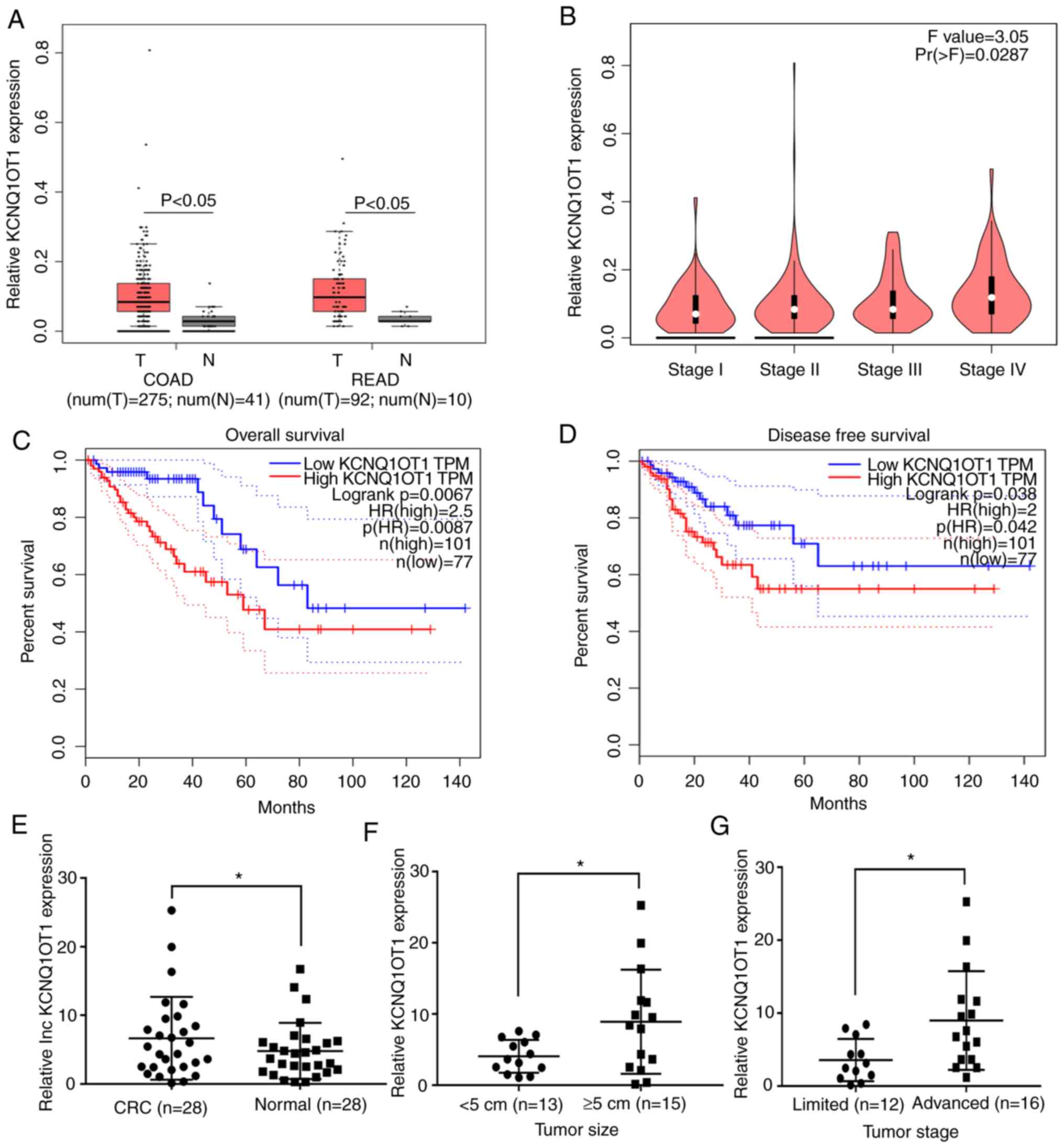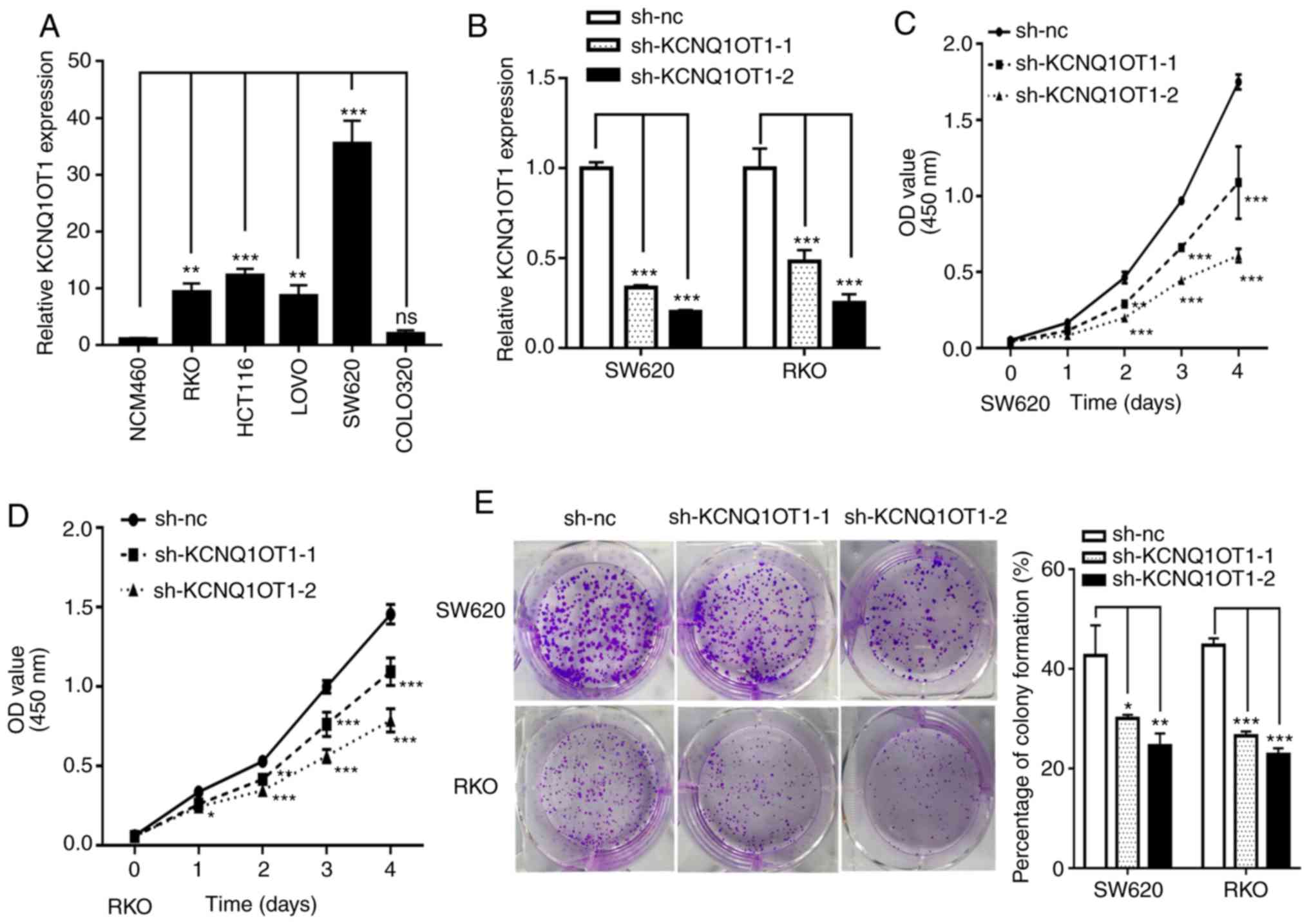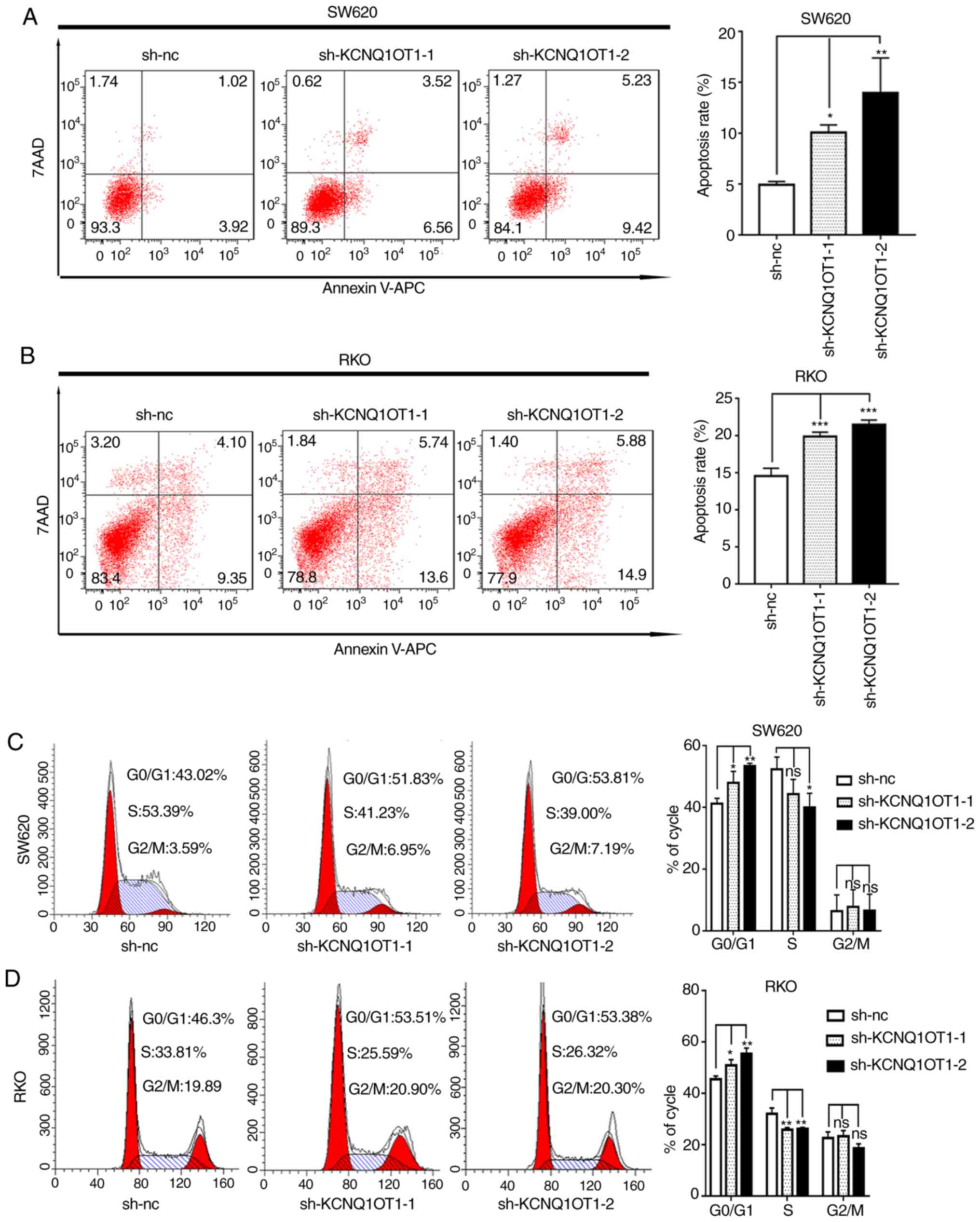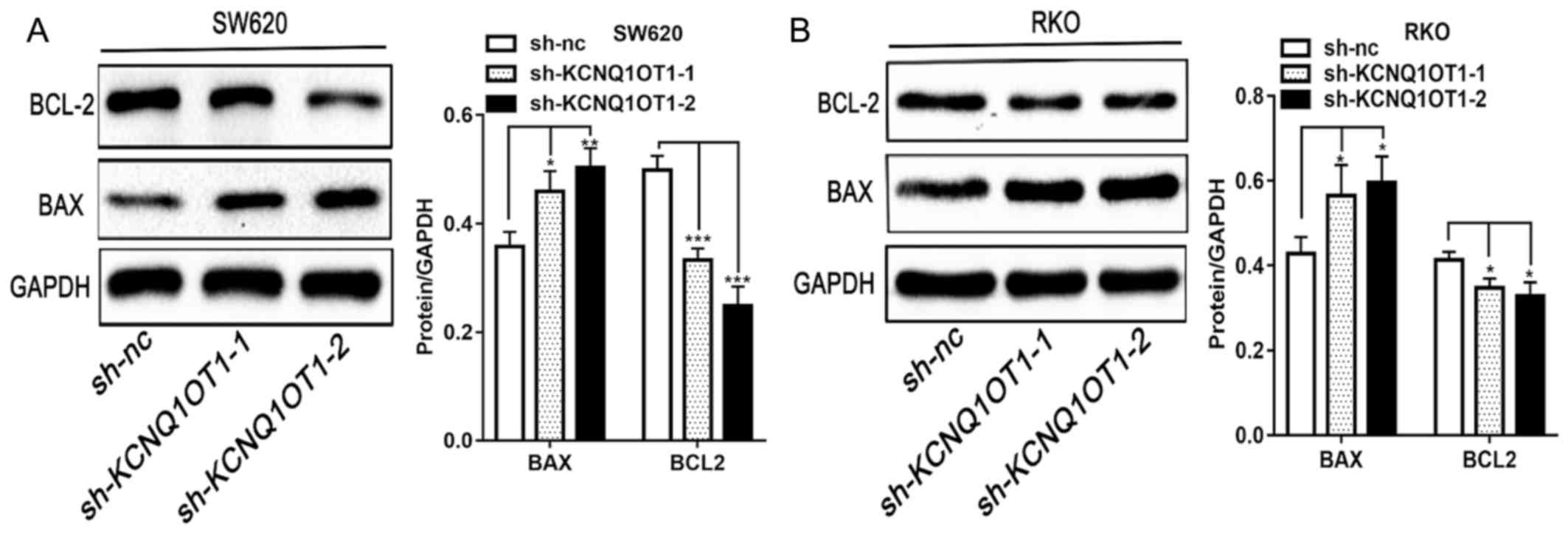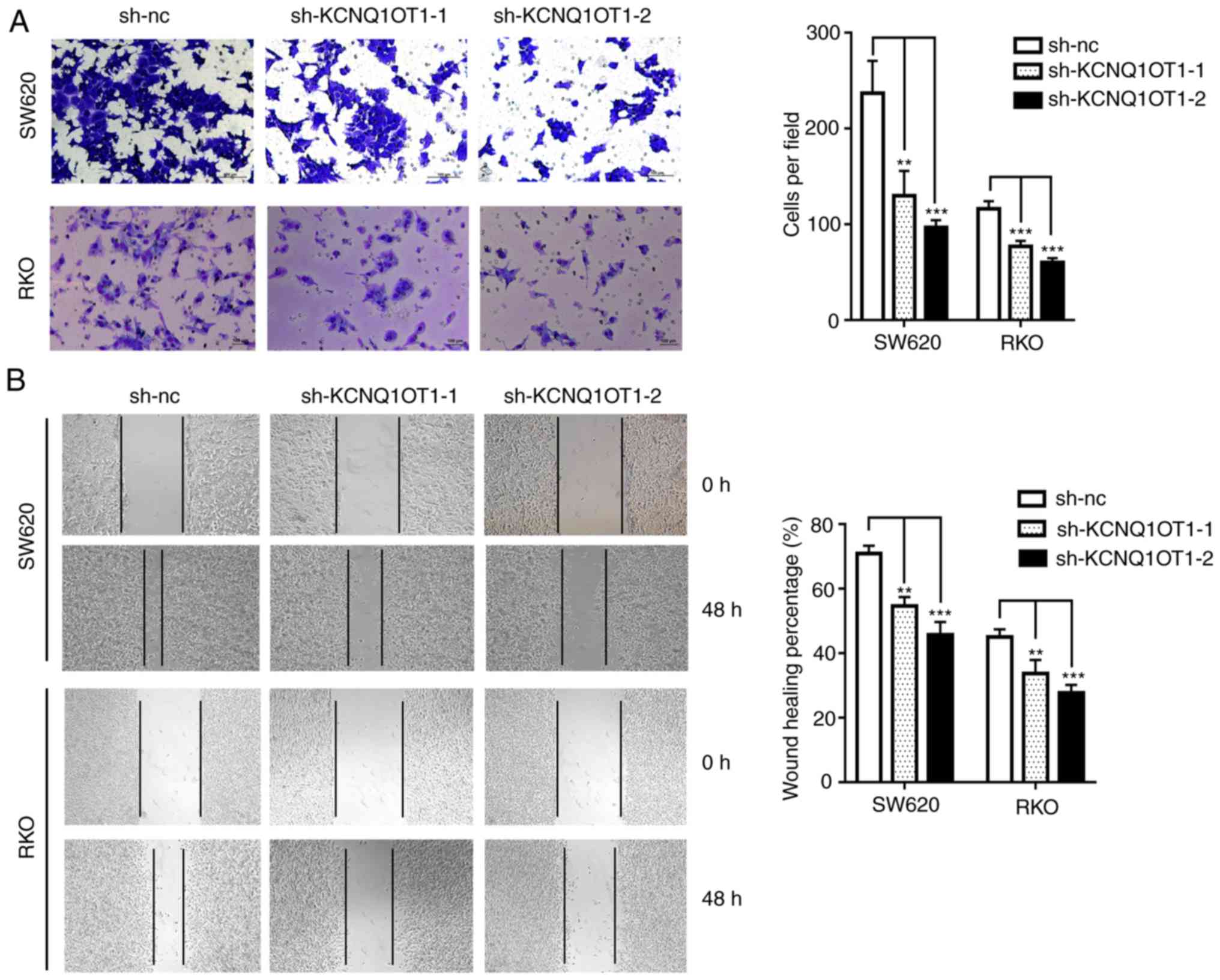lncRNA KCNQ1OT1 knockdown inhibits colorectal cancer cell proliferation, migration and invasiveness via thePI3K/AKT pathway
- Authors:
- Published online on: May 13, 2020 https://doi.org/10.3892/ol.2020.11619
- Pages: 601-610
-
Copyright: © Duan et al. This is an open access article distributed under the terms of Creative Commons Attribution License.
Abstract
Introduction
Colorectal cancer (CRC) is the third most diagnosed cancer worldwide with a high mortality rate, which reported 1.4 million new cases and 693,900 mortalities in 2012 (1). Based on the thorough understanding of the CRC pathological process, immunotherapy and targeted therapy have emerged and have greatly improved the prognosis of patients with CRC (2). However, because the occurrence and development of CRC is a complex process caused by numerous factors, the prognosis of patients with advanced-stage CRC remains unsatisfactory (3). It is therefore crucial to identify the underlying mechanisms of CRC tumorigenesis, in order to develop novel therapeutic strategies.
The human genome consists of 2% genes coding for proteins and several non-coding RNAs (ncRNAs) (4). Long non-coding (lnc)RNAs are a type of ncRNAs that are defined as transcripts with lengths >200 nucleotides, and that are not translated into proteins (5,6). Although lncRNAs were previously considered as transcriptional noise, previous studies have reported that lncRNAs serve crucial roles in the regulation of biological processes involved in numerous diseases, including various types of cancer (6,7). Previous studies have reported that the lncRNA KCNQ1OT1 is involved in the progression of multiple tumors, including tongue cancer, hepatocellular carcinoma, and breast cancer (8–10). However, the underlying mechanisms of KCNQ1OT1 in CRC development and metastasis remain unknown.
The present study investigated KCNQ1OT1 expression in CRC tissues and its association with the prognosis of patients with CRC. Furthermore, the role of KCNQ1OT1 in CRC cell proliferation, migratory and invasive abilities, apoptosis and the cell cycle was also analyzed. The underlying mechanisms of KCNQ1OT1 in CRC cells were subsequently investigated, which may help to provide a new therapeutic and prognostic method for colorectal cancer.
Materials and methods
Clinical samples
A total of 28 pairs of CRC and adjacent normal tissues (>5 cm from the edge of tumor tissues) were collected from patients with CRC between June 2018 and January 2019 at Zhujiang Hospital, Southern Medical University, and preserved in liquid nitrogen. All tissue samples were confirmed by histopathology, and tumor staging was based on the NCCN Colon Cancer Guidelines (11). The clinicopathological information of all patients, including age, sex, tumor size, pathological differentiation and Tumor-Node-Metastasis TNM, were collected at the Department of General Surgery of Zhujiang Hospital, Southern Medical University. The patients recruited in the present study suffered from colon adenocarcinoma (COAD) or rectum adenocarcinoma (READ), and all data were analyzed together. The present study was approved by the Ethics Committee of Zhujiang Hospital. All patients provided written informed consent prior to the study.
Bioinformatics analysis
Gene Expression Profiling Interactive Analysis (GEPIA http://gepia.cancer-pku.cn/) is an online web server used for the analysis of RNA sequencing expression data of 9,736 tumor samples and 8,587 normal samples from The Cancer Genome Atlas (https://www.cancer.gov) and the Genotype-Tissue Expression (https://commonfund.nih.gov/GTEx) databases, using a standard processing pipeline (12). Following submission of an analysis request, GEPIA can provide the visual image results for users (12). The gene symbol KCNQ1OT1 was submitted on GEPIA for differential expression analysis between data from CRC and normal tissues, and provided results consisting of box plots, stage plots and survival analysis.
Cell culture
The human CRC cell lines RKO, SW620, colo320, HCT116 and LoVo, and the normal colon epithelial cell line NCM460 were obtained from the Southern Medical University Corporation. All cells were maintained in RPMI-1640 (HyClone; GE Healthcare Life Sciences) containing 10% FBS (Serana Europe GmbH) and placed at 37°C in a humidified incubator containing 5% CO2.
PI3K inhibitor was purchased from Selleck Chemicals. The stably transfected SW620 and RKO cells were treated with 10 µM PI3K inhibitor (LY294002) for 24 h (13) to suppress the PI3K/AKT signaling pathway when the density of cells reached 50%.
RNA extraction and reverse transcription-quantitative (RT-q) PCR
Total RNA was extracted from the primary tissues and cell lines using TRIzol™ reagent (Takara Bio, Inc.), and reverse transcribed into cDNA with the PrimeScript RT Kit (Takara Bio, Inc.) according to the manufacturers' instructions. RT-qPCR reactions were performed as follows: 37°C for 15 min, followed by 85°C for 5 sec. qPCR was performed using the TB Green premix (Takara Bio, Inc.) in a CFX96 real-time PCR detection system (Bio-Rad Laboratories, Inc.). The sequences of the primers (Sangon Biotech, Co., Ltd.) were as follows: KCNQ1OT1 forward, 5′-CAAGCAGCCAGAAGGATGAGAAGG-3′ and reverse 5′-GGTCAGCACCAGAAGGCAGAATG-3′; and GAPDH forward, 5′-TGCACCACCAACTGCTTAGC-3′ and reverse 5′-GGCATGCACTGTGGTCATGAG-3′. The relative expression level of KCNQ1OT1 normalized to endogenous control and expressed as 2−ΔΔCq (14).
Lentivirus production and transfection
Short hairpin RNAs (shRNAs) against human KCNQ1OT1 (sh-KCNQ1OT1-1 and sh-KCNQ1OT1-2) or scrambled oligonucleotides (sh-nc) were ligated into a LV-5 (EF-1αF/GFP+Puro) vector (all from Shanghai GenePharm Co., Ltd.). Lentivirus solution (108 TU/ml) was transfected into the SW620 and RKO lines using Lipofectamine 3000 (Thermo Fisher Scientific, Inc,). The stably transfected cells were selected by puromycin selection (5 µg/ml) for ≥2 weeks. Subsequent experiments were performed after 2 weeks of cell transfection.
Cell viability assay
The stably transfected SW620 and RKO cells were seeded into 96-well plates at the density of 2×103 cells per well. Cell viability was assessed every 24 h for 5 days using the Cell Counting-Kit 8 reagent (CCK-8; Beijing Transgen Biotech Co., Ltd.). Briefly, cells were incubated with 10 ul CCK-8 solution for 2 h and absorbance was read at 450 nm on a microplate reader.
Colony formation assay
The stably transfected cells were seeded in 6-well plates at a density of 2×103 cells/well and cultured at 37°C for 12–14 days. Once the colonies were visible, cells were washed twice with PBS, and colonies were fixed with 5% paraformaldehyde for 20 min at room temperature and stained with 0.1% crystal violet (1 mg/ml) for 20 min. The stained colonies were counted, and the colony formation rate was calculated using ImageJ 8.0 software (National Institutes of Health).
Wound healing assay
The stably transfected cells were seeded into 6-well plates at a density of 5×105 cells/well and cultured until they had reached 90% confluence. The complete medium was replaced with serum-free medium and the cell monolayer was scratched with a sterile 100-µl pipette tip. After further culture for 48 h, the wound gap was observed under an inverted light microscope (magnification ×100). The extent of wound healing was calculated using the ImageJ 8.0 software. The wound healing percentage was calculated using the following formula: (Scratch healing area)/(original scratch area) ×100%.
Invasion assays
The stably transfected cells were suspended in serum-free medium at a density of 2×105 cells/200 µl and seeded into the Matrigel-coated upper chamber (8-µm pore size) of Transwell inserts in 24-well plates at 37°C for 1 h. the lower chamber was filled with 600 µl complete medium. Following 48 h of culture, cells remaining on the upper surface of the filter were swabbed off using cotton wool, and cells that had invaded the lower surface were fixed with 5% paraformaldehyde for 20 min at room temperature and stained with Giemsa for 10 min. Cells were observed under an inverted light microscope (magnification ×200), and the number of cells per field was calculated using ImageJ 8.0 software.
Cell cycle and apoptosis analysis
The stably transfected SW620 and RKO cells were trypsinized (without EDTA) and washed with PBS. For cell cycle analysis, 105 cells/100 µl cells were fixed with 70% ethanol at 4°C for 12 h and resuspended in staining buffer containing 450 µl propidium iodide (PI) and 50 µl RNaseA in the dark for 30 min at room temperature (cat. no. KGA512; Nanjing KeyGen Biotech Co., Ltd.) For apoptosis analysis, the Annexin V APC/7AAD apoptosis kit (cat. no. KGF004; Nanjing KeyGen Biotech Co., Ltd.) was used to stain for early and late apoptotic cells according to the manufacturers' instructions. Subsequently, stained cells were analyzed using a BD FACS-Verse flow cytometer (BD Biosciences). Cell cycle distribution was obtained using ModFit 3.2 software (Verity Software House, Inc.), and the apoptosis rate was calculated using FlowJo 7.6.1 software (FlowJo LLC).
Western blotting
Total proteins were extracted from cells and tissues using the Protein Extraction Kit (cat. no. KGP2100; Nanjing KeyGen Biotech Co., Ltd.) and quantified with a BCA assay (Nanjing KeyGen Biotech Co., Ltd. KGPBCA). Proteins (20 ug) were separated by 12% SDS-PAGE (Fude Biological Technology, Co. Ltd.) and transferred onto polyvinylidene fluoride membranes (EMD Millipore). The membranes were blocked with 5% skim milk (Fude Biological Technology, Co., Ltd.) for 1.5 h at room temperature, and incubated with primary antibodies against: PI3K (Wanleibio Co., Ltd.; cat. no. WL03380; 1:1,000), phosphorylated (p-) PI3K (Wanleibio Co., Ltd.; cat. no. WL0226; 1:1,000), AKT (Wanleibio Co., Ltd.; cat. no. WL003b; 1:1,000), p-AKT (Wanleibio Co., Ltd.; cat. no. WLP001a; 1:1,000), BAX (ProteinTech Group, Inc.; cat. no. 50599-2-lg; 1:5,000), BCL2 (ProteinTech Group, Inc.; cat. no. 12789-1-AP; 1:5,000) and GAPDH (Bioworld Technology, Inc.; cat. no. BS60630; 1:10,000) overnight at 4°C. The membranes were then incubated with goat-anti-rabbit secondary antibody (Fude Biological Technology, Co. Ltd.; cat. no. FDR007; 1:2,000) for 1 h at room temperature. The immuno-positive bands were visualized using ECL developer solution (Fude Biological Technology, Co., Ltd.) and an imaging system (Bio-Rad Laboratories, Inc.).
Statistical analysis
All statistical analyses were performed using GraphPad Prism 7.0 (GraphPad Software, Inc.). Data were presented as the means ± standard deviation of at least three independent experiments. Differences between two groups were assessed using the t-test, whereas one-way ANOVA, followed by Newman-Keuls post-hoc test were used to compare differences between multiple groups (>2). P<0.05 was considered to indicate a statistically significant difference.
Results
KCNQ1OT1 expression is upregulated in CRC tissues and is associated with disease progression and poor survival in patients with CRC
Previous studies have reported that KCNQ1OT1 expression is upregulated in various types of tumor, including hepatocellular carcinoma, non-small cell lung cancer and tongue cancer (8,9,15), and that this is correlated with poor prognosis in patients. In the present study, GEPIA was used to predict KCNQ1OT1 expression in CRC. The results from box plot analysis in GEPIA demonstrated that KCNQ1OT1 expression was significantly higher in tumor tissues compared with normal tissues in patients with COAD and READ (P<0.05; Fig. 1A). The results from stage plot analysis in GEPIA demonstrated that KCNQ1OT1 expression increased with tumor stage progression in patients with CRC (P=0.0287; Fig. 1B). Furthermore, results from survival analysis in GEPIA demonstrated that high KCNQ1OT1 expression in CRC tissues was associated with lower overall and disease-free survival times (Fig. 1C and D). These predicted results suggest that KCNQ1OT1 expression may be upregulated in CRC tissues and may be associated with poor prognosis in patients with CRC.
Subsequently, 28 pairs of CRC and adjacent normal tissues were collected from patients with CRC, and KCNQ1OT1 expression was examined by RT-qPCR. The results demonstrated that the KCNQ1OT1 expression level was significantly higher in CRC tissues compared with adjacent normal tissues (P=0.0142; Fig 1E). Furthermore, KCNQ1OT1 expression level was significantly higher in CRC tissues obtained from large tumors (≥5 cm) compared with those obtained from small tumors (<5 cm; P=0.0302; Fig. 1F). In addition, the KCNQ1OT1 expression level in CRC tissues obtained from patients with advanced stage CRC (IIIB+IIIC+IV) was significantly increased compared with those obtained from patients with limited stage disease (I+II+IIIA; P=0.0372; Fig. 1G). These findings indicate that KCNQ1OT1 may be associated with tumor growth and metastasis in CRC.
KCNQ1OT1 knockdown inhibits CRC cell proliferation in vitro
To investigate the role of KCNQ1OT1 in CRC growth, in vitro experiments were performed. Firstly, KCNQ1OT1 expression was assessed by RT-qPCR in five CRC cell lines and the normal NCM460 intestinal epithelial cell line. The results demonstrate that KCNQ1OT1 expression level was upregulated in four out of five CRC cell lines compared with the normal cell line (Fig. 2A). SW620 and RKO cells were subsequently selected to construct stably transfected cell lines using two KCNQ1OT1-specifc shRNAs lentivirus or negative control lentivirus. The results from RT-qPCR demonstrate that KCNQ1OT1 expression level was efficiently knocked down in the two cell lines following transfection (Fig. 2B). Subsequently, cell viability and colony formation assays were performed to investigate the effect of KCNQ1OT1 on CRC cell proliferation in vitro. The results demonstrate that KCNQ1OT1 knockdown significantly decreased SW620 and RKO cell viability (Fig. 2C and D). Furthermore, the results of the colony formation assay demonstrated that KCNQ1OT1 knockdown significantly inhibited clone formation capacity in SW620 and RKO cells (Fig. 2E). These findings confirm that KCNQ1OT1 knockdown inhibits CRC cell proliferation.
KCNQ1OT1 knockdown stimulates CRC cell apoptosis and cell cycle arrest
A previous study reported that abnormal cell cycle and apoptosis are associated with cancer growth (16). To better understand the underlying mechanism of KCNQ1OT1 in CRC cell proliferation, apoptosis and cell cycle distribution were evaluated in the present study. The results demonstrated that the apoptotic rates of KCNQ1OT1 knockdown SW620 and RKO cells were significantly increased compared with the control cells (Fig. 3A and B). Furthermore, as presented in Fig. 4A and B, the expression of the pro-apoptotic protein BAX and of the anti-apoptotic protein BCL-2, in KCNQ1OT1 knockdown CRC cells was significantly increased and decreased, respectively, compared with control group. The results from western blotting are therefore consistent with results from apoptosis detection by flow cytometry. In addition, the results from cell cycle analysis demonstrated that KCNQ1OT1 knockdown significantly increased the percentage of cells in the G0/G1 phase and decreased the percentage of cells in the S phase in SW620 and RKO cell lines, compared with control cells (Fig. 3C and D). These findings suggest that downregulation of KCNQ1OT1 in CRC cells may induce apoptosis and arrest the cell cycle at the G0/G1 phase.
KCNQ1OT1 knockdown inhibits CRC cell migratory and invasive abilities
In order to investigate the biological function of KCNQ1OT1 in CRC cell invasiveness, a Transwell assay was performed. The results demonstrate that the invasive ability of KCNQ1OT1 knockdown cells was significantly decreased compared with control cells (Fig. 5A). Similarly, the results from the wound healing assay demonstrated that silencing KCNQ1OT1 in SW620 or RKO cells significantly decreased the scratch healing ability (Fig. 5B). These results indicate that KCNQ1OT1 knockdown may decrease CRC cell invasion in vitro.
KCNQ1OT1 knockdown inhibits the activation of the PI3K/AKT signaling pathway
Previous studies have reported that the PI3K/AKT pathway is one of the most commonly altered pathways in human cancer that is associated with the regulation of tumor growth and metastasis (17,18). In order to identify the underlying mechanism of KCNQ1OT1 in CRC progression, the PI3K/AKT pathway was investigated. To do so, the expression of proteins from the PI3K/AKT pathway was analyzed by western blotting in CRC cells transfected with sh-KCNQ1OT1 or sh-nc. The results demonstrate that KCNQ1OT1 knockdown inactivates the PI3K/AKT pathway, as evidenced by the decreased expression of p-PI3K and p-AKT in SW620 and RKO cell lines (Fig. 6A and B). In addition, following CRC cell treatment with a PI3K inhibitor, the level of p-PI3K and p-AKT was decreased compared with non-treated cells (Fig. 6C and D). The inhibition experiment was successful, confirming that KCNQ1OT1 inhibited the proliferation and invasion of colorectal cancer by inhibiting the PI3K signaling pathway. These data suggest that KCNQ1OT1 knockdown may inhibit PI3K/AKT signaling pathway activation.
Discussion
Numerous studies have demonstrated that lncRNAs serve crucial roles in malignant tumor progression, including CRC (5,19). For example, Chen et al (20) reported that lncRNA XIST is significantly overexpressed in tumors from patients with CRC and is associated with poor overall survival. Furthermore, it was demonstrated that XIST can regulate CRC progression and metastasis by competing with the micro-RNA miR-200b for the regulation of zinc finger E-box binding homeobox 1 expression (20). In addition, Han et al (21) reported that lncRNA CRNDE could promote chemoresistance and CRC cell proliferation by regulating the expression levels of miR-181a-5p and the activity of the Wnt/β-catenin signaling pathway. A previous study reported that β-catenin could directly target KCNQ1OT1 to promote CRC development (22). However, the role and underlying mechanism of KCNQ1OT1 in CRC remains unclear.
The present study demonstrated that KCNQ1OT1 is highly expressed in CRC tissues compared with normal tissues, and that high KCNQ1OT1 expression in CRC tissues is associated with poor survival according to GEPIA predictions. These results were similar to those observed in 28 CRC tissue samples, in which KCNQ1OT1 was upregulated compared with adjacent normal tissues. Furthermore, KCNQ1OT1 expression was significantly associated with tumor size (<5 cm vs. ≥5 cm) and clinical stage (limited vs. advanced). These results suggest that high KCNQ1OT1 expression may be associated with the malignant progression of CRC. Previous research demonstrates that KCNQ1OT1 overexpression serves a crucial role in various types of tumor. For example, it was reported that KCNQ1OT1 is upregulated in chemoresistant tongue squamous cell carcinoma tissues compared with chemosensitive tissues, and that high KNCQ1OT1 expression is positively correlated with poor prognosis in patients (8). Another study demonstrated that KCNQ1OT1 is highly expressed and promotes tumor growth and metastasis in cholangiocarcinoma via miR-140-5p/SRY-box transcription factor 4 axis (23). It was demonstrated that KCNQ1OT1 is upregulated in patients with hepatocellular carcinoma (9), breast cancer (10), non-small-cell lung cancer (15) and glioma (24), and that it promotes malignant tumor progression. The results from these studies indicate that KCNQ1OT1 may serve an oncogenic role in various types of cancer.
The present study demonstrated that KCNQ1OT1 knockdown inhibited the proliferation and migratory and invasive abilities of CRC cells, which was consistent with previous studies on cholangiocarcinoma and hepatocellular carcinoma (9,23). Numerous studies have reported that the cell cycle and apoptosis are associated with cancer cell proliferation and tumor growth (16,25,26). Subsequently, KCNQ1OT1 was knocked down in the present study and the cell cycle and apoptosis were evaluated. The results demonstrated that KCNQ1OT1 knockdown promoted apoptosis and cell cycle arrest in CRC cells. These findings indicate that KCNQ1OT1 may regulate CRC cell proliferation, migratory and invasive abilities, cell cycle and apoptosis in order to promote tumor growth and metastasis.
The PI3K/AKT signaling pathway serves an essential role in the growth and metastasis of multiple tumors. For example, lncRNA ABHD11-AS1 promotes tumor progression by regulating PI3K/AKT signaling in papillary thyroid carcinoma (27). In addition, lncRNA SNHG7 facilitates CRC cell proliferation and metastasis via the PI3K/AKT/mTOR signaling pathway, and by regulating GALNT7 expression via miR-34a sponging (28). Following PI3K/AKT pathway inactivation, G1/S transition, proliferation and migratory and invasive abilities of cancer cells are inhibited, whereas apoptosis is stimulated (17,28). The results from the present study demonstrate that KCNQ1OT1 knockdown decreases the protein expression of p-PI3K and p-AKT. These findings suggest that CRC cell proliferation and metastasis may be regulated by KCNQ1OT1 via the PI3K/AKT signaling pathway.
In conclusion, the present study demonstrated that KCNQ1OT1 expression was significantly increased in CRC cells and tissues compared with normal cells and tissues. Furthermore, KCNQ1OT1 knockdown inhibited CRC cell proliferation and migratory and invasive ability, promoted CRC cell apoptosis and arrested the cell cycle via PI3K/AKT signal pathway inactivation. These findings indicate that KCNQ1OT1 may be considered as a potential prognostic marker and therapeutic target for CRC. However, the study had several limitations. For example, the effect of KCNQ1OT1 overexpression in CRC cells in vitro or its function in vivo, were not investigated. Future studies will further explore the underlying mechanisms of KCNQ1OT1 in CRC, in particular, its potential role as a competitive endogenous RNA.
Acknowledgements
Not applicable.
Funding
The present study was supported by the Natural Science Foundation of Guangdong Province, China (grant no. 2017A030313533).
Availability of data and materials
The data generated during the study are included in this article.
Authors' contributions
JY and CC designed the present study. QD and LC conducted the main experiments and drafted the initial manuscript. KZ conducted some minor experiments in this study. RH, CW and LX analyzed the bioinformatics databases and assessed the expression levels in clinical tissues. ZZ and XY analyzed the data. All authors read and approved the final manuscript.
Ethics approval and consent to participate
The present study was approved by the Ethics Committee of Zhujiang Hospital, Southern Medical University (approval no. 2018-PTWK-005). All patients signed informed consent prior to the study.
Patient consent for publication
Not applicable.
Competing interests
The authors declare that they have no competing interests.
References
|
Torre LA, Bray F, Siegel RL, Ferlay J, Lortet-Tieulent J and Jemal A: Global cancer statistics, 2012. CA Cancer J Clin. 65:87–108. 2015. View Article : Google Scholar : PubMed/NCBI | |
|
Li Y, Liang L, Dai W, Cai G, Xu Y, Li X, Li Q and Cai S: Prognostic impact of programed cell death-1 (PD-1) and PD-ligand 1 (PD-L1) expression in cancer cells and tumor infiltrating lymphocytes in colorectal cancer. Mol Cancer. 15:552016. View Article : Google Scholar : PubMed/NCBI | |
|
Markowitz SD and Bertagnolli MM: Molecular origins of cancer: Molecular basis of colorectal cancer. N Engl J Med. 361:2449–2460. 2009. View Article : Google Scholar : PubMed/NCBI | |
|
ENCODE Project Consortium, . An integrated encyclopedia of DNA elements in the human genome. Nature. 489:57–74. 2012. View Article : Google Scholar : PubMed/NCBI | |
|
Esteller M: Non-coding RNAs in human disease. Nat Rev Genet. 12:861–874. 2011. View Article : Google Scholar : PubMed/NCBI | |
|
Wang KC and Chang HY: Molecular mechanisms of long noncoding RNAs. Mol Cell. 43:904–914. 2011. View Article : Google Scholar : PubMed/NCBI | |
|
Schmitz SU, Grote P and Herrmann BG: Mechanisms of long noncoding RNA function in development and disease. Cell Mol Life Sci. 73:2491–2509. 2016. View Article : Google Scholar : PubMed/NCBI | |
|
Zhang S, Ma H, Zhang D, Xie S, Wang W, Li Q, Lin Z and Wang Y: LncRNA KCNQ1OT1 regulates proliferation and cisplatin resistance in tongue cancer via miR-211-5p mediated Ezrin/Fak/Src signaling. Cell Death Dis. 9:7422018. View Article : Google Scholar : PubMed/NCBI | |
|
Li C, Miao R, Zhang J, Qu K and Liu C: Long non-coding RNA KCNQ1OT1 mediates the growth of hepatocellular carcinoma by functioning as a competing endogenous RNA of miR-504. Int J Oncol. 56:857–858. 2020.PubMed/NCBI | |
|
Feng W, Wang C, Liang C, Yang H, Chen D, Yu X, Zhao W, Geng D, Li S, Chen Z and Sun M: The dysregulated expression of KCNQ1OT1 and Its interaction with downstream factors miR-145/CCNE2 in breast cancer cells. Cell Physiol Biochem. 49:432–446. 2018. View Article : Google Scholar : PubMed/NCBI | |
|
NCCN Clinical Practice Guidelines in Oncology (NCCN Guidelines®)-Colon Cancer v1.2019. March 15–2019 | |
|
Tang Z, Li C, Kang B, Gao G, Li C and Zhang Z: GEPIA: A web server for cancer and normal gene expression profiling and interactive analyses. Nucleic Acids Res. 45:W98–W102. 2017. View Article : Google Scholar : PubMed/NCBI | |
|
Wang Y, Kuang H, Xue J, Liao L, Yin F and Zhou X: LncRNA AB073614 regulates proliferation and metastasis of colorectal cancer cells via the PI3K/AKT signaling pathway. Biomed Pharmacother. 93:1230–1237. 2017. View Article : Google Scholar : PubMed/NCBI | |
|
Livak KJ and Schmittgen TD: Analysis of relative gene expression data using real-time quantitative PCR and the 2(-Delta Delta C(T)) method. Methods. 25:402–408. 2001. View Article : Google Scholar : PubMed/NCBI | |
|
Dong Z, Yang P, Qiu X, Liang S, Guan B, Yang H, Li F, Sun L, Liu H, Zou G and Zhao K: KCNQ1OT1 facilitates progression of non-small-cell lung carcinoma via modulating miRNA-27b-3p/HSP90AA1 axis. J Cell Physiol. 234:11304–11314. 2019. View Article : Google Scholar : PubMed/NCBI | |
|
Evan GI and Vousden KH: Proliferation, cell cycle and apoptosis in cancer. Nature. 411:342–348. 2001. View Article : Google Scholar : PubMed/NCBI | |
|
Huang JL, Cao SW, Ou QS, Yang B, Zheng SH, Tang J, Chen J, Hu YW, Zheng L and Wang Q: The long non-coding RNA PTTG3P promotes cell growth and metastasis via up-regulating PTTG1 and activating PI3K/AKT signaling in hepatocellular carcinoma. Mol Cancer. 17:932018. View Article : Google Scholar : PubMed/NCBI | |
|
Lien EC, Dibble CC and Toker A: PI3K signaling in cancer: Beyond AKT. Curr Opin Cell Biol. 45:62–71. 2017. View Article : Google Scholar : PubMed/NCBI | |
|
Schmitt AM and Chang HY: Long noncoding RNAs in cancer pathways. Cancer Cell. 29:452–463. 2016. View Article : Google Scholar : PubMed/NCBI | |
|
Chen DL, Chen LZ, Lu YX, Zhang DS, Zeng ZL, Pan ZZ, Huang P, Wang FH, Li YH, Ju HQ and Xu RH: Long noncoding RNA XIST expedites metastasis and modulates epithelial-mesenchymal transition in colorectal cancer. Cell Death Dis. 8:e30112017. View Article : Google Scholar : PubMed/NCBI | |
|
Han P, Li JW, Zhang BM, Lv JC, Li YM, Gu XY, Yu ZW, Jia YH, Bai XF, Li L, et al: The lncRNA CRNDE promotes colorectal cancer cell proliferation and chemoresistance via miR-181a-5p-mediated regulation of Wnt/β-catenin signaling. Mol Cancer. 16:92017. View Article : Google Scholar : PubMed/NCBI | |
|
Sunamura N, Ohira T, Kataoka M, Inaoka D, Tanabe H, Nakayama Y, Oshimura M and Kugoh H: Regulation of functional KCNQ1OT1 lncRNA by β-catenin. Sci Rep. 6:206902016. View Article : Google Scholar : PubMed/NCBI | |
|
Sun H, Li Y, Kong H, Dai S and Qian H: Dysregulation of KCNQ1OT1 promotes cholangiocarcinoma progression via miR-140-5p/SOX4 axis. Arch Biochem Biophys. 658:7–15. 2018. View Article : Google Scholar : PubMed/NCBI | |
|
Gong W, Zheng J, Liu X, Liu Y, Guo J, Gao Y, Tao W, Chen J, Li Z, Ma J and Xue Y: Knockdown of long non-coding RNA KCNQ1OT1 restrained glioma cells' malignancy by activating miR-370/CCNE2 axis. Front Cell Neurosci. 11:842017. View Article : Google Scholar : PubMed/NCBI | |
|
Huang M, Wang H, Hu X and Cao X: lncRNA MALAT1 binds chromatin remodeling subunit BRG1 to epigenetically promote inflammation-related hepatocellular carcinoma progression. Oncoimmunology. 8:e15186282018. View Article : Google Scholar : PubMed/NCBI | |
|
Wang Z and Qin B: Prognostic and clinicopathological significance of long noncoding RNA CTD-2510F5.4 in gastric cancer. Gastric Cancer. 22:692–704. 2019. View Article : Google Scholar : PubMed/NCBI | |
|
Wen J, Wang H, Dong T, Gan P, Fang H, Wu S, Li J, Zhang Y, Du R and Zhu Q: STAT3-induced upregulation of lncRNA ABHD11-AS1 promotes tumour progression in papillary thyroid carcinoma by regulating miR-1301-3p/STAT3 axis and PI3K/AKT signalling pathway. Cell Prolif. 52:e125692019. View Article : Google Scholar : PubMed/NCBI | |
|
Li Y, Zeng C, Hu J, Pan Y, Shan Y, Liu B and Jia L: Long non-coding RNA-SNHG7 acts as a target of miR-34a to increase GALNT7 level and regulate PI3K/Akt/mTOR pathway in colorectal cancer progression. J Hematol Oncol. 11:892018. View Article : Google Scholar : PubMed/NCBI |



